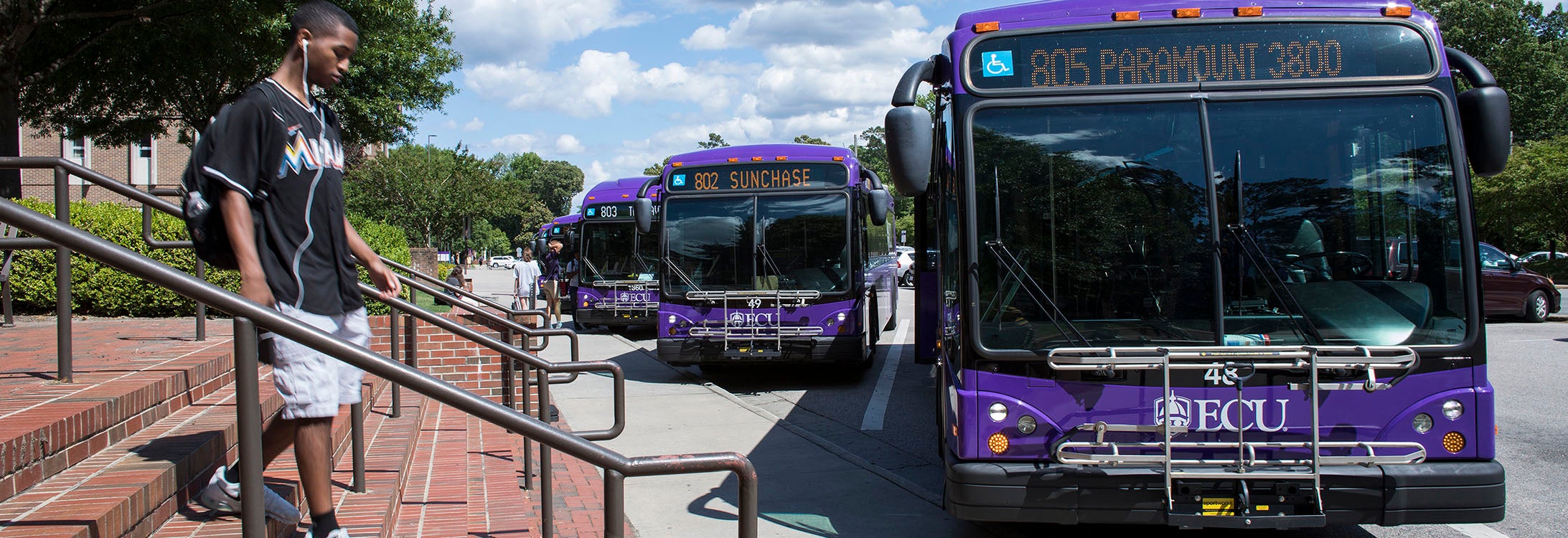Riders Guide
The ECU Transit Rider Guide is available as a PDF download and printed versions can also be found in various locations around campus including the Neighborhood Service Office. This guide is intended to help our riders make the most out of using ECU Transit by answering common questions and explaining some aspects of our operations in more detail.
Download the Spring 2025 – Rider Guide (PDF)
Rider Guidelines & Rules
Safety: Priority One
Safety is of the utmost importance in all aspects of ECU Transit operations. Stop locations, service schedules, equipment selection, policies and more are all taken into consideration for the safety of our riders, employees, and others in the community. It is important to recognize everyone’s role in being safe.
Below are a few ways you can help keep yourself and others safe when using the system:
Stand back from the curb
To ease the process of boarding and alighting, our operators align their vehicles to be close to, or sometimes even over, the curb. While waiting for the bus, please stand back from the curb to allow the operator ample room to maneuver and stop safely.
Do not approach vehicles in motion
It is important to allow the bus to come to a complete stop before approaching it. A moving vehicle is always dangerous, especially if you approach from an angle where the driver cannot see you.
Be seated, hold on
Always take a seat when possible while riding the bus. Seated riders are much less likely to be injured in the event sudden maneuvers are necessary, or if there is an accident or other emergency situation. If you must stand, use the handrails or grab straps to secure yourself.
Remain behind the line
Our operators will not permit anyone to stand forward of the standee line at the front of the bus; if there is no room remaining for you to stand behind the line, you will be asked to step off the bus. Riders who stand in front of this line not only obscure the operator’s view but are also at greater risk of injury if the bus must stop suddenly or is involved in an accident.
Designated stops only
Stop locations are chosen with safety in mind; vehicle operators are not allowed to stop at other locations. This also means the operator cannot open the doors once the bus has left the curb to discourage riders from endangering themselves to catch a missed bus. Never run after a bus once it has pulled away from the curb. There are many blind spots and the driver may not see you.
Tips for Your Trip
In addition to the above safety guidelines, there are several things you can do to help make your trip go more smoothly.
While You Wait
Arrive at your stop a few minutes early to allow for traffic conditions. Stop times listed for many locations are approximate and the bus may arrive slightly earlier or later depending on traffic conditions.
During peak times
The bus may reach capacity and be unable to accept additional riders. When the bus is full and no one indicates a desire to get off at the next stop, the operator will not stop for waiting passengers.
When the bus approaches your stop, make sure you are visible to the operator. This is especially important if you are waiting alone or at a stop along a busy street. If he or she cannot see you, they will not stop unless other riders are trying to get off at your location.
Boarding the Bus
Before stepping onto the bus, allow others to exit first if they must do so through the front door. Board through the front door and exit through the rear door if available. Please board and be seated quickly to avoid delays. During peak periods, fill rear seating first all the way to the front, then standing room from the rear to the front. Also, try to make as much standing room as possible so the bus can carry more passengers.
During Your Trip
If a rider in a wheelchair boards the bus, riders seated in the ADA securement area must relinquish their seats at the operator’s request to accommodate the wheelchair.
Some vehicles are equipped with opening windows and roof vents/hatches.
- Please keep your head and arms inside the bus at all times.
- Do not smoke, eat, or drink on the bus.
- Place all trash in the wastebasket near the door.
- Please keep headset volumes low and cell phone conversations to a minimum to avoid distracting the operator or other riders.
Exiting the Bus
Pull the stop request cord or press the stop request bar prior to your stop. You must make the request when you are still a reasonable distance from the stop. The operator will not be able to safely stop the bus if the request is made too late and too close to the stop. In these instances, the operator will stop at the next scheduled stop. You can pull the cord or press the bar shortly after leaving the previous stop to ensure your stop is not missed. On some routes, the operator will not stop if there are no visible riders waiting at a bus stop or if there is no request to exit the bus. Exit using the rear door. Please exit quickly to avoid delays.
